In an ever-evolving world where industrial practices and daily living environments become more complex, understanding and mitigating physical hazards cannot be overstated. Physical hazards are elements or conditions that can cause harm to individuals through physical contact or exposure. These hazards are not restricted to any particular setting, as they can be found everywhere, from construction sites and manufacturing facilities to offices and even our homes. Understanding the different types of physical hazards is the first step toward creating safer environments for everyone involved.
This insightful blog will take you through 10 examples of physical hazards, providing a comprehensive understanding of each. Not only will we delve into what each hazard entails, but we will also explore their potential effects on health and safety. But that’s not all – recognizing a problem is only half the battle. This is why, in addition to identifying these hazards, we will discuss practical control measures that can be employed to minimize or even eliminate the risks associated with each hazard.
Whether you are an employer looking to ensure the safety of your workforce, an employee aiming to be cognizant of the hazards in your workplace, or simply an individual who wants to make informed decisions for a safer living environment, this blog is a must-read.
What is a Physical Hazard?
A physical hazard refers to any factor or condition in our surroundings, natural or work-related, that can cause bodily injury. These hazards can manifest in numerous forms, including but not limited to risks from electricity, issues causing trips and falls, or problems arising from poor ergonomics.
Regarding occupational health and safety, physical hazards are often a significant cause of workplace injuries. Thus, spotting and tackling these hazards is critical to maintaining a safe work environment. Techniques to identify these hazards might include carrying out dynamic risk assessments and employing other hazard identification procedures.
Once you’ve identified these physical hazards, the next step is to set up and execute measures to safeguard the workforce. Common strategies to manage these hazards involve administrative controls (like rules, training, or shift rotations), engineering controls (like machine guards or sound barriers), and Personal Protective Equipment (PPE), like safety glasses, gloves, or hard hats. These control methods are vital in mitigating the potential harm caused by physical hazards.
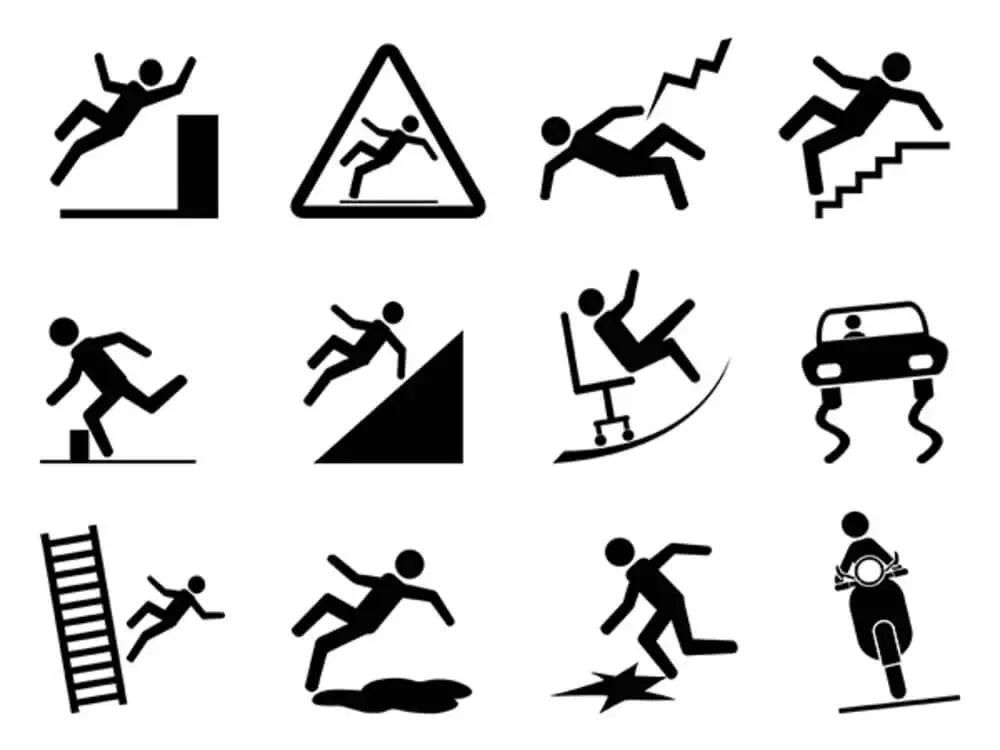
Physical Hazards Examples
Physical hazards are environmental elements that can cause harm without touching you. These hazards can be present in various settings, such as the workplace, home, or natural environment. Below are examples of physical hazards and their control measures:
1. Slips And Trips
Slips, trips, and falls are prevalent examples of physical hazards in various environments, including workplaces, homes, and public spaces.
- Slips happen when insufficient traction between a person’s foot and the surface they are walking on. This can be caused by wet or oily floors, freshly waxed surfaces, or loose materials such as gravel. Slips can cause someone to lose balance, resulting in falls and injuries.
- Trips occur when someone unexpectedly catches their foot on an object or surface. This can be due to clutter, poor lighting, uneven flooring, or walkway obstacles, such as electrical cords or loose carpeting. Tripping can cause a person to stumble or fall forward, leading to injuries.
- Falls are often a consequence of slips or trips but can also be caused by other factors, such as working at heights or using ladders and stairs. Falls can be particularly dangerous, resulting in severe injuries such as fractures, head trauma, or even fatalities.
Prevention and Control: To reduce the risk of slips, trips, and falls, it’s important to implement preventive measures. These include keeping walkways clear of clutter, ensuring that flooring is in good condition, using non-slip mats, ensuring adequate lighting, and training staff on safety procedures.
2. Falls from Height
Falls from height refer to incidents where individuals fall from a certain elevation instead of falling on the same level (such as slipping on a wet floor). This type of physical hazard is particularly common in construction, warehousing, and maintenance industries. Still, it can also occur in any environment where work is being done at an elevated level, such as climbing a ladder at home.
The consequences of falls from height can be extremely severe, including broken bones, spinal injuries, and even fatalities. The severity of injuries generally increases with the height of the fall.
Causes:
- Inadequate Safety Equipment: Not using or accessing appropriate safety equipment like harnesses, guardrails, or safety nets.
- Poor Training: Lack of proper training on how to work safely at heights.
Unsafe Working Conditions: Working on unstable surfaces or in adverse weather conditions that make surfaces slippery. - Lack of Fall Protection Plans: The absence of an evaluated and properly implemented plan to prevent falls.
Prevention and Control:
- Use of Personal Protective Equipment (PPE): Ensure workers are equipped with the appropriate PPE, such as harnesses, helmets, and non-slip footwear.
- Engineering Controls: Implement physical changes to the work environment, such as installing guardrails, toe boards, and safety nets.
- Regular Inspection and Maintenance: Regularly inspect and maintain equipment like ladders, scaffolding, and harnesses to ensure they are in good working condition.
- Fall Protection Plans: Develop and implement a comprehensive fall protection plan that assesses the risks and outlines specific measures for preventing falls.
- Emergency Response Plan: Have a plan in place for prompt medical attention in case a fall from height occurs.
Recognizing the hazards associated with working at heights and implementing appropriate preventive measures can significantly reduce the risks of falls from heights.
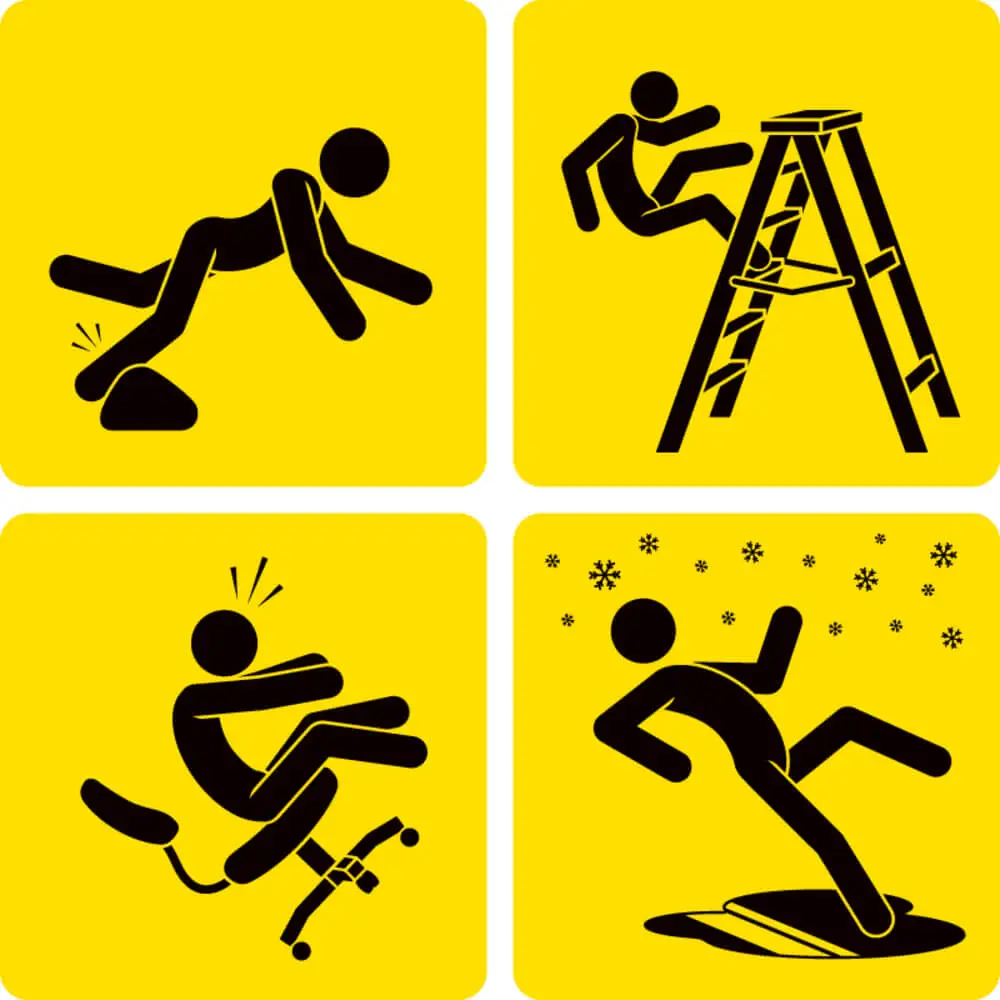
3. Confined Spaces
Confined spaces refer to enclosed areas with limited access and are not intended for continuous human occupancy. Examples include tanks, silos, pipelines, sewers, vaults, and tunnels. Due to their nature, confined spaces can pose various physical hazards.
Here are some of the common hazards associated with confined spaces:
- Lack of Oxygen: The space may not have adequate oxygen levels for safe breathing. This can be due to the consumption of oxygen by a chemical process or the displacement of oxygen by another gas.
- Toxic Gases or Fumes: Chemical reactions, decomposition of organic material, or the presence of contaminants can produce harmful gases within confined spaces.
- Explosive or Flammable Atmosphere: Flammable gases, vapors, or dust can cause the air within the confined space to become explosive.
- Engulfment: Individuals inside a confined space might be engulfed by loose materials such as sand, grain, or liquids that can fill the space rapidly.
- Difficulty in Entry or Exit: Confined spaces often have limited or restricted means for entry and exit, making it difficult for workers to escape in an emergency.
- Physical Hazards from Machinery or Processes: Confined spaces might contain machinery or processes that can pose physical hazards such as moving parts, electrical, or hot surfaces.
Prevention and Control:
- Hazard Assessment: Before entry, evaluate the confined space for potential hazards, such as testing the air for toxic gases and ensuring adequate oxygen.
- Use of PPE: Equip workers with the appropriate Personal Protective Equipment, such as respirators, gloves, and protective clothing.
- Ventilation: Implement ventilation systems to ensure fresh air is circulated within the confined space, helping control hazardous atmospheres.
- Monitoring: Continuously monitor the air quality within the confined space for changes in oxygen levels or toxic gases.
- Emergency Procedures: Develop and practice emergency response procedures specific to confined spaces, and ensure that rescue equipment is available and in good working condition.
- Permit System: Implement a permit-required confined space program, allowing entry only to authorized personnel under specific conditions.
- Lockout/Tagout: Ensure that all mechanical and electrical equipment inside the confined space is de-energized and cannot be accidentally started while workers are inside.
By understanding the unique hazards that confined spaces present and implementing these preventive and control measures, the safety of workers can be greatly enhanced.
4. Electrical Hazards
Electrical hazards pertain to potential dangers associated with using electricity, which can cause shocks, burns, fires, and even fatalities. These hazards are common in various environments, including workplaces, homes, and public spaces. Here are some of the common electrical hazards and ways to prevent and control them:
- Electric Shocks: Electric shocks occur when a person comes into contact with an electrical energy source. Shocks can result from direct contact with live wires, faulty electrical equipment, or wet surfaces conducting electricity. The severity can range from a slight tingling to severe internal injuries or cardiac arrest.
- Electrical Burns: These occur when an electric current passes through the body or when one gets too close to a high-current source. Electrical burns are often more severe than burns from heat, as electricity can cause damage deep within tissues.
- Electrocution: This is a fatal incident due to an electric shock and is often the result of exposure to high-voltage electricity.
- Fires and Explosions: Electrical hazards can also cause fires and explosions. Faulty wiring, overloaded circuits, or the improper use of electrical equipment can lead to sparks which can ignite flammable materials.
Prevention and Control:
- Training and Education: Educate people about the dangers of electricity and train them on safe practices, especially in workplaces where individuals are regularly exposed to electrical equipment.
- Regular Inspections and Maintenance: Regularly inspect electrical equipment and wiring to ensure they are in good condition. Replace or repair any damaged equipment or wiring.
- Use of Personal Protective Equipment (PPE): Ensure that individuals working with or around electricity wear appropriate PPE, such as insulated gloves, non-conductive footwear, and safety goggles.
- Circuit Breakers and Fuses: Utilize circuit breakers and fuses to protect electrical circuits from overloading and potentially causing fires.
- Lockout/Tagout Procedures: In workplaces, implement lockout/tagout procedures to ensure that electrical equipment is de-energized during maintenance or repair.
- Maintaining a Safe Environment: Keep the environment around electrical equipment dry and free from clutter. Avoid using electrical equipment in wet conditions; if necessary, use Ground Fault Circuit Interrupters (GFCI) for protection.
- Compliance with Regulations: Ensure compliance with local electrical safety regulations and standards, as they provide guidelines for maintaining electrical safety.
Electrical hazards can be significantly mitigated Through training, equipment maintenance, protective measures, and adherence to regulations, reducing the risk of injuries and damage.
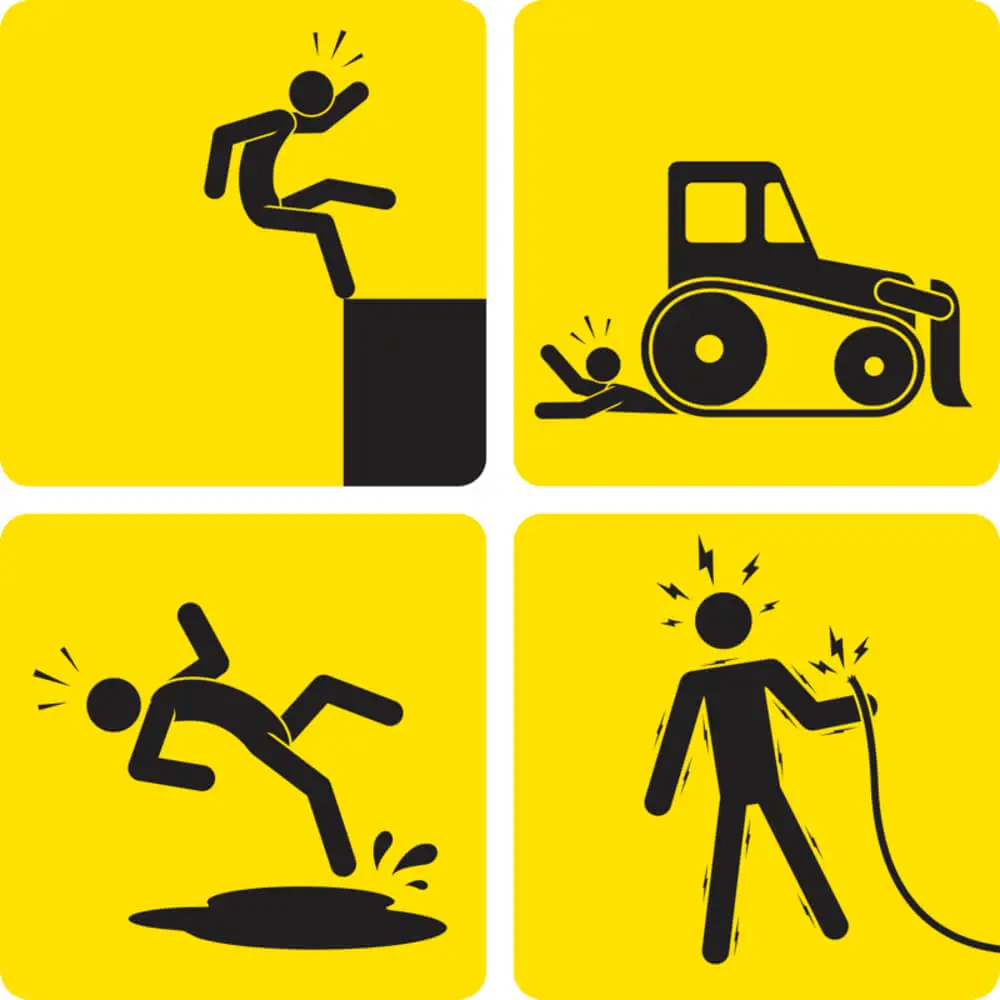
5. Fire and Explosions
Fires and explosions are physical hazards that involve the rapid oxidation of materials through combustion, releasing heat, light, and various reaction products. These events can cause severe harm to people, damage property, and disrupt operations. Fires and explosions can occur in various settings, including workplaces, homes, and public areas.
Causes:
- Flammable and Combustible Materials: The presence of gases, liquids, or solids that can easily ignite and sustain a fire.
- Ignition Sources: These include open flames, electrical sparks, hot surfaces, or any heat source that is sufficient to ignite flammable materials.
- Oxygen: Fires need oxygen to sustain combustion. This can also include oxidizing agents that intensify a fire in an industrial setting.
- Chemical Reactions: Certain chemical reactions can generate enough heat to ignite nearby combustible materials.
- Equipment Failure: Faulty or poorly maintained equipment can generate sparks or heat, acting as an ignition source.
- Poorly Stored Pressurized Materials: If containers of pressurized flammable materials are not stored properly, they can rupture and cause an explosion.
Prevention and Control:
- Proper Storage: Store flammable and combustible materials in appropriate containers and in designated areas away from ignition sources.
- Good Ventilation: In areas where flammable gases or vapors may be released, use proper ventilation to reduce the concentration of these materials in the air.
- Regular Inspection and Maintenance: Regularly inspect and maintain equipment and machinery to minimize the risk of mechanical failure that could cause sparks or heat.
- Fire Suppression Systems: Install fire suppression systems, such as sprinklers and fire extinguishers, in areas with a fire risk.
- Emergency Response Plan: Develop and practice an emergency response plan, including evacuation procedures, for what to do in the event of a fire or explosion.
- Eliminate Ignition Sources: Keep open flames, sparks, and hot surfaces away from areas where flammable materials are handled or stored. Use intrinsically safe equipment where needed.
Understanding the causes of fires and explosions and implementing comprehensive preventive and control measures can significantly reduce the risk and impact of these physical hazards.
6. Exposure to Extreme Temperatures
Exposure to extreme temperatures, either too hot or too cold, can pose serious health risks and is considered a physical hazard. It can occur in various settings, including workplaces like construction sites, refrigerated storage areas, kitchens, foundries, and outdoors, especially in extreme climates.
- Heat-Related Hazards: Prolonged exposure to high temperatures can lead to a variety of heat-related illnesses such as heat stroke, heat exhaustion, heat cramps, and heat rash. These conditions can be severe and potentially life-threatening, particularly heat stroke which requires immediate medical attention. Workers exposed to hot environments are at risk, as are those wearing heavy protective clothing or personal protective equipment (PPE) even in moderate temperatures.
- Cold-Related Hazards: On the other end of the spectrum, exposure to extreme cold can lead to frostbite, hypothermia, and trench foot. Such conditions can occur in refrigerated environments, outdoor work in cold climates, or in water environments. Frostbite can lead to permanent tissue damage, while hypothermia, a significant drop in body temperature, can be life-threatening.
Prevention and Control:
- Proper Clothing: Wear appropriate clothing for the conditions. In cold environments, layers can help insulate against the cold. In hot conditions, lightweight, breathable clothing is best.
- Regular Breaks: Take regular breaks to cool down or warm up as necessary. Break rooms should be at a comfortable temperature.
- Training: Provide training on recognizing the symptoms of heat and cold-related illnesses and what to do if someone shows signs of these conditions.
- Hydration: Ensure water is readily available to prevent dehydration, particularly in hot environments.
- Proper Equipment: Use equipment designed to protect against extreme temperatures. This can include cooling vests for hot environments or insulated gloves and boots for cold ones.
- Risk Assessment: Carry out risk assessments to identify who may be at risk from extreme temperatures, and put measures in place to protect them.
- Adaptation Periods: Gradually expose workers to extreme temperatures, giving their bodies time to adapt.
- Emergency Procedures: Have procedures for dealing with heat and cold-related emergencies, including appropriate first aid equipment and trained first aiders.
- Scheduled Work: If possible, schedule work to avoid the hottest part of the day and the coldest part in cold climates.
By understanding the risks associated with exposure to extreme temperatures and implementing these measures, the impact of this physical hazard can be significantly mitigated.
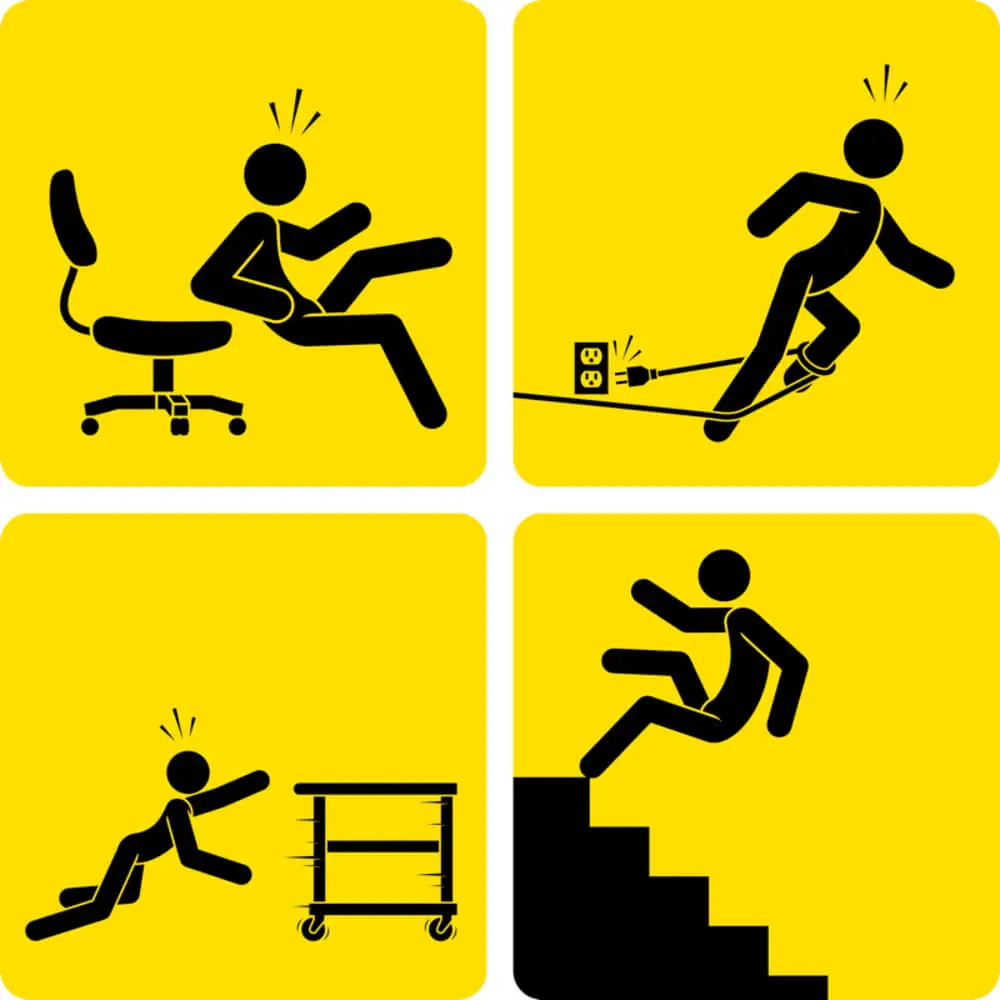
7. Machinery and Equipment
Machinery and equipment hazards refer to risks associated with using machines and equipment in various settings like factories, construction sites, farms, and even offices. These hazards can result from moving parts, sharp edges, electrical components, and human interaction with machinery. Improper use, lack of maintenance, and inadequate training can escalate the risks.
Common Hazards and Risks:
- Entanglement: Clothing, hair, or body parts can get caught in the moving parts of machinery, causing injuries or even amputations.
- Cuts and Abrasions: Sharp edges or moving parts such as blades and gears can cause cuts or abrasions.
- Crushing: Heavy machinery or its parts can trap and crush limbs or the whole body.
- Electrical Hazards: Many machines operate on electricity, and faulty wiring or malfunctions can cause electric shocks or electrocution.
- Ergonomic Hazards: Improper design or machinery setup can cause strain injuries due to repetitive motions or uncomfortable positions.
- Noise: Machinery often generates high noise levels, which can cause hearing loss over time.
- Flying Debris: Machines that cut, grind, or shape materials can eject particles quickly, potentially causing eye injuries or other harm.
Prevention and Control:
- Regular Maintenance and Inspection: Regularly maintain and inspect machinery to ensure it is in good working condition. Replace or repair any malfunctioning components.
- Use of Personal Protective Equipment (PPE): Ensure workers use appropriate PPE, such as gloves, safety glasses, ear protection, and protective clothing.
- Machine Guarding: Install physical barriers or guards to prevent access to moving parts, sharp edges, or areas where flying debris is generated.
- Emergency Stop Buttons: Equip machinery with easily accessible emergency stop buttons to quickly shut down the machine in an emergency.
- Lockout/Tagout Procedures: Implement procedures to ensure that machines are de-energized and cannot be started inadvertently during maintenance or repair.
- Clear Work Areas: Keep work areas around machinery free of clutter and ensure sufficient space for safe operation.
- Safety Signage: Use signs and labels to clearly indicate potential hazards associated with machinery and the required safety procedures.
Recognizing the potential hazards associated with machinery and equipment and implementing these safety measures can significantly reduce the risk of injuries and accidents.
8. Vehicle Accidents
Vehicle accidents refer to incidents where vehicles collide with other vehicles, pedestrians, animals, or objects or when they roll over. These accidents can occur in various settings, including roads, highways, construction sites, warehouses, and any place vehicles operate. Vehicle accidents are physical hazards that can result in injuries, fatalities, and property damage.
Common Causes:
- Distracted Driving: Use mobile phones, eating, or any activity that distracts the driver from driving.
- Speeding: Driving at speeds higher than what is safe for road conditions can result in losing control.
- Impaired Driving: Driving under the influence of alcohol or drugs impairs judgment and reaction times.
- Fatigue: Drowsy driving can be as dangerous as driving under the influence, as reaction times are slower and the ability to focus on the road is diminished.
- Weather Conditions: Rain, snow, fog, and ice can make driving hazardous.
- Poor Vehicle Maintenance: Failure to maintain the vehicle properly, such as worn-out brakes or bald tires, can lead to accidents.
- Reckless Driving: Aggressive driving behavior like tailgating, not yielding the right of way, or not observing traffic signals.
Prevention and Control:
- Driver Education and Training: Provide education and training for drivers on safe driving practices and the dangers of distracted or impaired driving.
- Vehicle Maintenance: Regularly inspect and maintain vehicles to ensure they are in safe working condition. This includes checking brakes, tires, lights, and other crucial components.
- Implement and Enforce Speed Limits: Adhere to posted speed limits and adjust driving speed according to road and weather conditions.
- Avoid Driving Under the Influence: Implement strict policies against driving under alcohol or drugs.
- Safe Loading: Ensure that vehicles are not overloaded and loads are properly secured to prevent shifting that could cause a loss of control.
- Emergency Preparedness: Ensure vehicles are equipped with emergency supplies and drivers are trained in emergency procedures.
- Road Safety Culture: Foster a safety culture within organizations and communities, promoting responsible driving habits.
Understanding the causes of vehicle accidents and implementing preventive and control measures can significantly reduce the risks associated with this physical hazard.
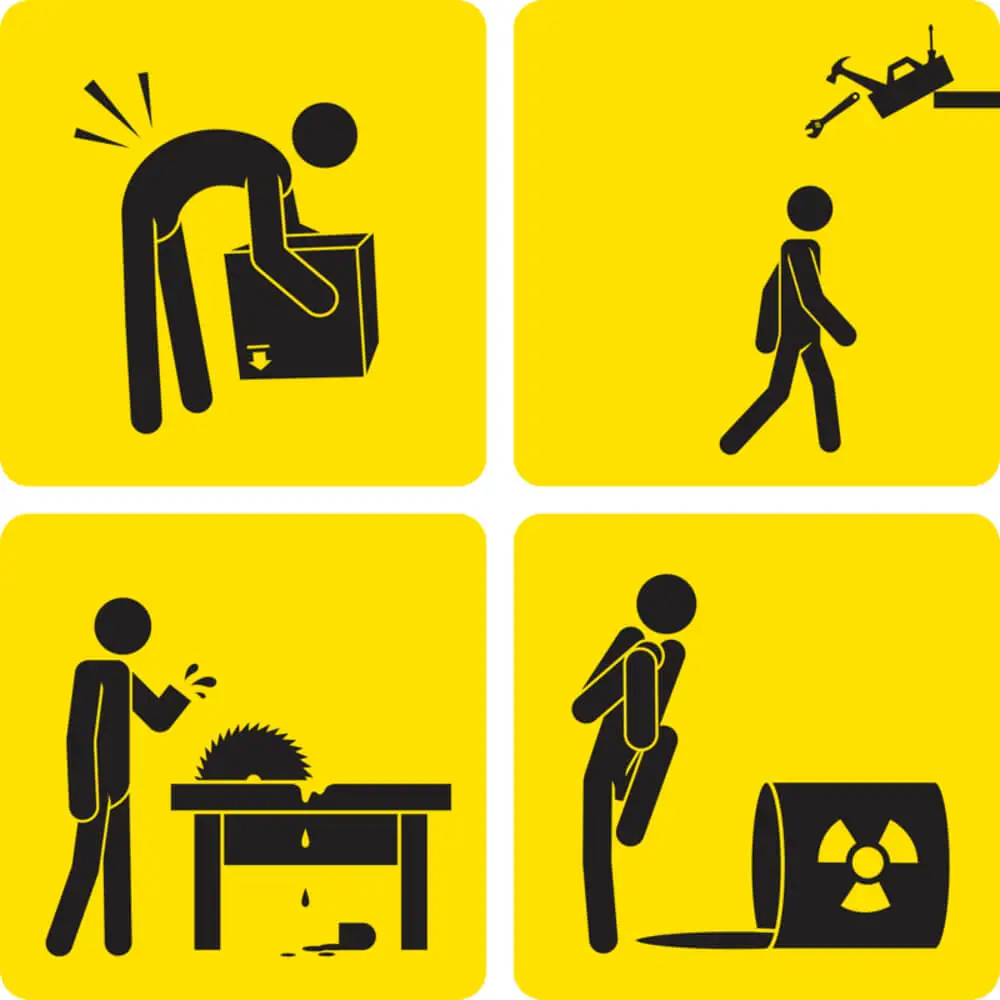
9. Noise
Noise as a physical hazard refers to exposure to high levels of sound that have the potential to cause harm to human health. This exposure can occur in various settings, such as industrial workplaces, construction sites, music venues, airports, and even urban living environments. Prolonged exposure to high noise levels can adversely affect hearing and general health.
Effects of Noise Exposure:
- Hearing Loss: Constant exposure to high noise levels can lead to noise-induced hearing loss. This can be either temporary or permanent.
- Tinnitus: A ringing, buzzing, or roaring sound in the ears, which can be temporary or chronic.
- Stress and Fatigue: Continuous noise exposure can cause increased stress levels, irritability, and fatigue.
- Sleep Disturbances: Nighttime noise can disrupt sleep patterns, leading to sleep deprivation and its associated health risks.
- Communication Issues: High noise levels can interfere with the ability to understand speech, which can be critical in safety-sensitive environments.
- Cardiovascular Issues: Some studies suggest that long-term exposure to high noise levels may be linked to an increased risk of cardiovascular diseases.
Prevention and Control:
- Noise Assessment: Conduct regular assessments to identify areas with high noise levels and determine which workers are at risk.
- Engineering Controls: Implement engineering solutions to reduce noise levels, such as using quieter machinery, installing sound barriers, or isolating the noise source.
- Administrative Controls: Implement work practices to reduce workers’ exposure to noise. This can include rotating workers through high-noise areas or scheduling noisy tasks with fewer people.
- Use of Personal Protective Equipment (PPE): Provide and ensure the use of appropriate hearing protection, such as earplugs or earmuffs, for workers exposed to high noise levels.
- Training and Education: Educate workers about the risks associated with noise exposure and the importance of using hearing protection.
- Noise Reduction in Design: When planning new facilities or equipment purchases, consider noise levels in the selection process.
- Health Surveillance: Conduct regular hearing tests for workers exposed to high noise levels to detect early signs of hearing loss.
- Regulatory Compliance: Ensure compliance with local regulations and standards regarding noise exposure limits and controls.
- Public Awareness: Public awareness campaigns about the risks of noise pollution and ways to minimize exposure (such as keeping windows closed in high-traffic areas) can benefit community exposure.
Understanding the risks associated with noise exposure and implementing preventive and control measures can mitigate the negative health effects of this physical hazard.
10. Vibration
Vibration as a physical hazard refers to oscillatory motions transmitted through a solid medium, such as the ground, a structure, or a tool. It can cause harm to health or safety. Two primary types of vibration can pose hazards: whole-body vibration and hand-arm vibration.
- Whole-Body Vibration (WBV) occurs when the entire body is exposed to vibration. It is common among workers who operate heavy vehicles or machinery, such as truck drivers, forklift operators, and construction equipment operators. WBV can contribute to lower back pain, spinal disorders, fatigue, and impaired balance.
- Hand-Arm Vibration (HAV): This is specific to the vibration transmitted to the hands and arms, often experienced by workers using vibrating tools such as jackhammers, grinders, and chainsaws. HAV can lead to a range of conditions collectively known as Hand-Arm Vibration Syndrome (HAVS), which includes vascular disorders (e.g., vibration white finger), nerve disorders, and muscle and joint issues in the hands and arms.
Effects of Vibration Exposure:
- Musculoskeletal Disorders: Long-term exposure to vibration can contribute to muscle, joint, and bone problems.
- Circulatory Problems: In the case of HAV, exposure can lead to reduced blood flow to the extremities.
- Nerve Damage: Exposure to vibration can cause damage to the nerves, leading to numbness or reduced sensation.
- Fatigue and Impaired Balance: Whole-body vibration can cause fatigue and impair a person’s balance, which might lead to accidents.
Prevention and Control:
- Risk Assessment: Conduct assessments to identify the sources of vibration and determine which workers are at risk.
- Engineering Controls: Implement measures such as using anti-vibration mounts or pads, selecting tools and equipment designed to minimize vibration, and regularly maintaining equipment to ensure it operates smoothly.
- Administrative Controls: Rotate workers through jobs that expose them to vibration to reduce exposure time, and provide adequate breaks. Implement training programs to ensure workers use equipment properly to minimize vibration.
- Use of Personal Protective Equipment (PPE): Provide and enforce the use of appropriate PPE, such as anti-vibration gloves and seats designed to reduce whole-body vibration.
- Health Surveillance: Conduct regular health checks for workers exposed to vibration to detect early signs of musculoskeletal disorders, nerve damage, or circulatory problems.
- Ergonomic Design: Opt for tools and equipment that are ergonomically designed to reduce the transmission of vibration to the body.
- Training and Education: Educate workers about the risks associated with vibration exposure, the importance of using PPE, and following good work practices.
- Regulatory Compliance: Adhere to local regulations and standards regarding exposure limits and vibration control.
By understanding the risks associated with vibration exposure and implementing effective control measures, the adverse health effects of this physical hazard can be significantly reduced.
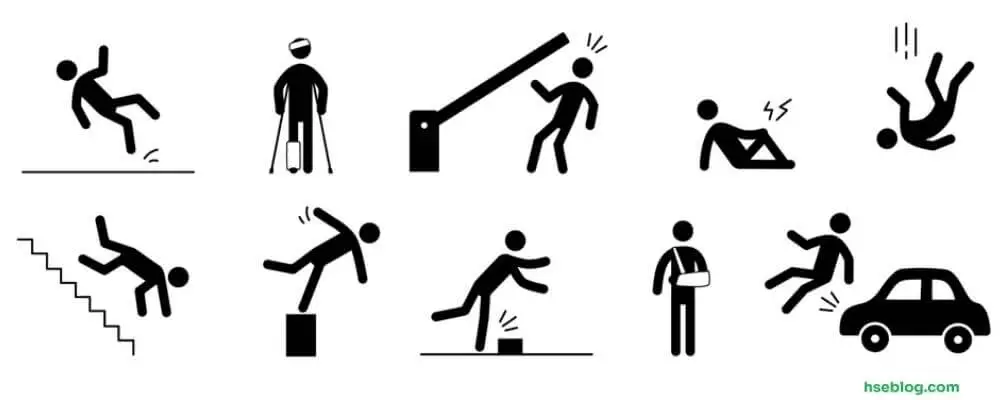
Additional Physical Hazards Examples
- Manual Handling and Lifting: This refers to tasks that require an individual to lift, lower, push, pull, carry, or otherwise move, hold, or restrain any person, animal, or item. Improper manual handling can lead to musculoskeletal injuries, particularly in the back and spine.
- Chemical Spills: The accidental release of chemicals can be hazardous, particularly if these chemicals are toxic, corrosive, or flammable. Such spills can cause burns, respiratory issues, and contamination.
- Ergonomic Hazards: These hazards arise from a workspace’s physical layout and setup. Poor ergonomics can lead to musculoskeletal disorders, eye strain, and other health issues. Common examples include poorly adjusted chairs, repetitive motions, and poor lighting.
- Radiation Exposure: Exposure to ionizing radiation from sources such as X-rays or radioactive materials can damage living tissue and increase cancer risk. Non-ionizing radiation from sources such as ultraviolet light can cause burns and eye injuries.
- Body Stressing includes various activities that can strain or stress the body, particularly muscles and joints. This can include repetitive movements, sustained postures, and handling heavy loads.
- Falling Objects: In workplaces where items are stored at height or during construction where work is being done above ground level, there is a risk of being struck by falling objects, which can cause serious injuries.
- Dust and Particulates: Exposure to dust and small particles can be a physical hazard, particularly in environments like construction sites or factories. Inhalation of these materials can cause respiratory issues.
- High-Pressure Systems: Working with or around high-pressure air or liquids, such as in hydraulic systems, poses a risk of explosions or ruptures, which can cause injuries.
- Extreme Lighting Conditions: Working in conditions with either too little or too much light can be a physical hazard. Insufficient lighting can lead to eye strain and accidents, while excessive lighting or glare can cause eye injuries.
- Biomechanical Hazards: These hazards are related to the interaction between the worker and their environment and include excessive force, awkward postures, and repetitive motions. Biomechanical hazards are closely related to ergonomic hazards but specifically focus on how the human body interacts with equipment and workstations.
Individuals and organizations must know these physical hazards to implement preventive measures and minimize the associated risk.
Conclusion
In conclusion, the awareness and understanding of the 10 different physical hazards we’ve explored are instrumental in fostering safer environments. Each hazard has unique risks, from slips and falls to radiation exposure. However, we can significantly mitigate these risks by employing the control measures discussed, such as engineering controls, administrative policies, and personal protective equipment. Vigilance, education, and a commitment to safety are key in protecting ourselves and our communities from the potentially devastating effects of these physical hazards.

